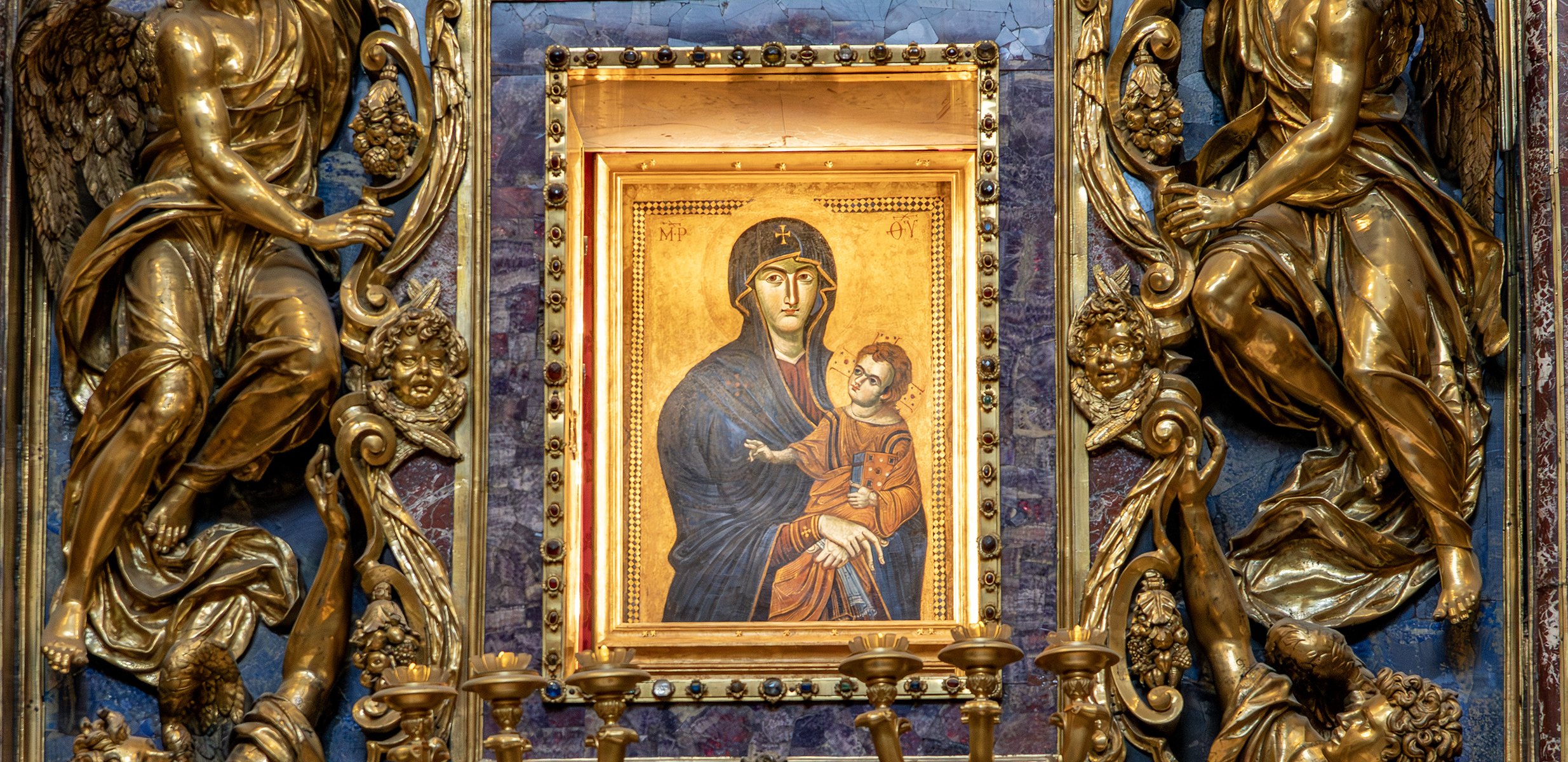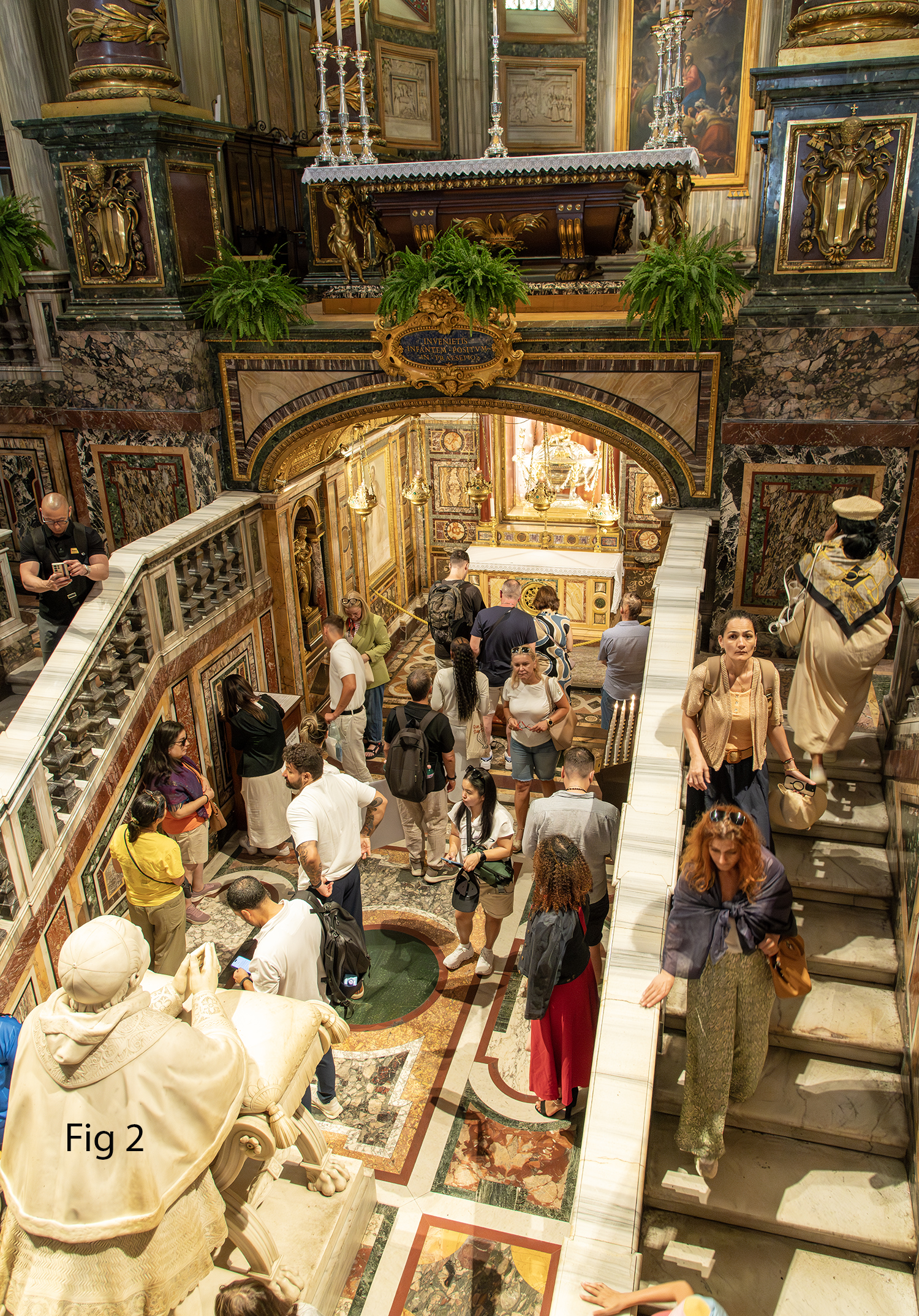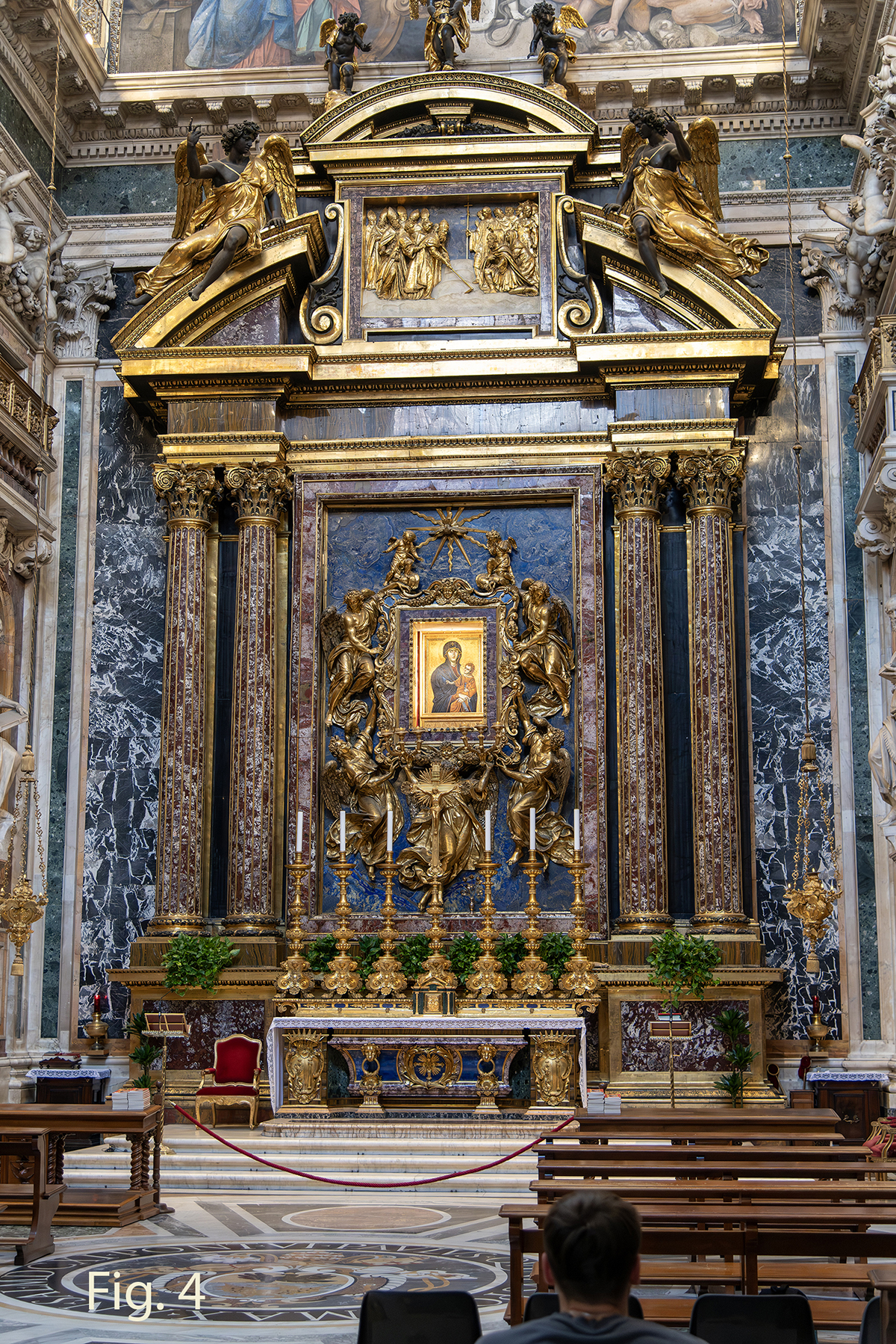
At the time of the first Jubilee Year in 1300 there was an annual procession from St. John Lateran to Sta. Maria Maggiore. During this procession, which took place on the Feast of the Assumption (15 August), one of the most precious icons in the Church’s possession – the Acheropita – was carried up the Esquiline hill to be placed near the venerated icon of Mary now known as the Salus Populi Romani. Both these images are reputed to have originated, in part, with St. Luke the Evangelist. The Salus Populi Romani was thought to have been painted from life. The Acheropita portrait of Christ was reputedly completed by angels. *
I set out with the goal of retracing this processional route. I failed. Instead, I had to console myself with visiting Sta Maria Maggiore the day after St. John Lateran and later taking in several of the churches on the ancient route (San Clemente and Sta. Prassede, a topic for another time).
But St. Mary Major holds many attractions and points for liturgical reflection. Unlike St. John Lateran, St. Mary is a three aisled basilica (fig. 1) to which transepts and a baptistry have been added. Like the other major basilicas, it also has a confessio beneath the papal altar (fig 2). In this case it contains what is said to be the manger in which the Christ child was laid at his birth. And it is here in this shrine that we discover something unique about this particular basilica.


All of the other three major basilicas are, in some way, associated with martyrdom. St. Peter, St. Paul, and John the Baptist. True, St. John the Evangelist, who is also associated with the Lateran, was not a martyr, but the Lateran confessio features a sculpture, not of the Evangelist, but of the Baptist. St. Mary Major, even in its various iconography, is especially focused on those narratives from the nativity and ultimate apotheosis of the Theotokos. Life, glorification, and Love are central.
Four areas of this basilica are worth reflection in this regard. The baptistry (fig. 3), the shrine of the Salus Populi Romani (fig. 4), the Sistine chapel of the Blessed Sacrament (fig 5), and the tomb of Pope Francis (fig 6).

The Baptistry (fig 3) has its own space on the northeast corner of the basilica near the entrance. Beyond the font itself is a relief sculpture of the Assumption. There is a theology of hope and love in this arrangement. Baptism, through which the redemptive and loving grace of salvation is poured out upon the initiate, finds its supreme conclusion in the fullness of the Beatific Vision. Mary is the exemplar of this embrace. In the Eastern tradition, August 15 is the Feast of the Dormition (falling asleep) of the Virgin. In the Western tradition it has become the Feast of the Assumption. In both expressions is a sign of the hope of the Faithful: the passage from death to Life and the joy of eternal immersion in the Love of God. For the liturgist, this iconography offers food for reflection when designing the place for baptism. The emphasis on love, life, hope and the abiding presence of God in angels, saints and the living Church is central to this profound sacrament.

As one arrives at the altar the shrine of the Salus Populi Romani (Health of the People of Rome) also has its own environment in the transept to the left (fig 4). This large icon is, according to legend, the work of St. Luke himself. What we see today is medieval overpainting, but evidence indicates a much older image under these later additions. The image has done its share of travelling as well. Originally hung over the main portal of the church, it was moved to the entrance of the Baptistry in medieval times. Its final journey was to its current chapel (also known as the Borghese Chapel) in 1613. This event is celebrated annually on the last Sunday of January.
The icon can be dated at least to the time of the Council of Ephesus (431) and is associated with numerous public miracles over the centuries since. It was a particular favorite of the late Pope Francis, hence his desire to be buried nearby. Mary’s gaze is toward the viewer, while Christ gazes at His mother. The pose is sometimes known as the sedes sapientia, the seat of wisdom, a title which refers specifically to Mary (Christ is Divine Wisdom seated on her lap). Christ’s gaze of love is directed toward humanity, personified and exemplified by his mother, the one who does the will of God. Mary becomes a type or metaphor for the Church, which looks outward toward all those who seek the way, truth and life in Christ. As a liturgical designer and consultant, the story and iconography of the Salus Populi Romani is a reminder that images can and sometimes should be moved from place to place in the church, that devotional space is deeply important, and that both must be so ordered that they lead to and flow from the Liturgy itself, which is ultimately the prime theology of Faith.

Opposite this shrine is the chapel of the Blessed Sacrament (Fig 5). As at St. John Lateran we see special space set apart for the reservation of the Eucharist. But woven into the Baroque splendor of this space is a theology of love and communion. As in the Baptistry, we see an iconography that celebrates Mary but in connection with Christ, here present sacramentally. Directly behind the tabernacle is a depiction of the nativity in Bethlehem. It is notable that one translation of this name is “House of Bread”. Thus, the impressive and enormous bronze temple by Ludovico del Duca (1590) is both a reference to the temple in Jerusalem and the place of Christ’s birth in Bethlehem. ** The “House of Bread” is now the “House of the Sacramental Bread”, the living presence through which Divine Love continues to intimately embrace humanity through eucharistic Communion. Those considering the place of reservation would do well to reflect on this when designing contemporary Eucharistic Chapels. Again, we see the links between Liturgy, Sacrament, and Salvation History, which itself is a history of the manifestation of Divine Love.
Certainly, there is far more at Sta. Maria Maggiore worthy of reflection, but these examples are particularly striking for the way they have expanded the typical iconography in innovative and uplifting ways. Little wonder, then, that this basilica was the favorite of the late Pope Francis and the place in which he now rests. The Pope’s tomb is near the shrine of the Salus Populi Romani and is in sharp contrast to the baroque tombs of the Counter-Reformation popes also interred in this church. Francis’ tomb (fig 6) is warmly simple, devoid of ostentation, proclamatory scripts, gold filigree, or dramatic focus. Indeed, if it were not for the extensive queue waiting to pause at his tomb, it would be almost invisible.

Francis’ papacy centered ultimately, like Sta Maria Maggiore, on Divine Love, mercy and abiding presence. Love for others, for humanity, for strangers, immigrants, the poor, and the natural world itself. For Francis, nothing and no one was denied the superabundant grace of God’s Love.
Let us bear this great truth with us in heart and mind as we now proceed south of the city to St. Paul’s Outside the Walls.
* An excellent volume on the subject is Kessler, Herbert L., Rome 1300: On the Path of the Pilgrim, Yale University Press, 2000.
**Note the similarities with the temple in Raphael’s “Marriage of the Virgin” (1504)